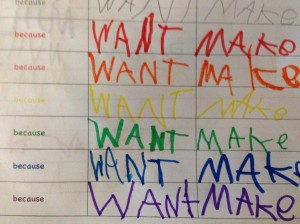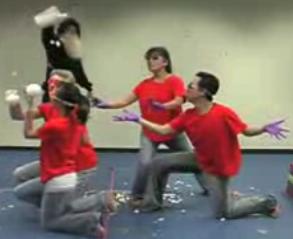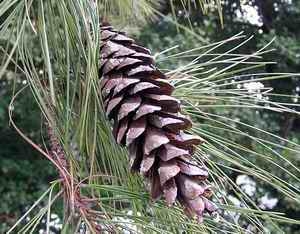At the RIT Center for MAGIC (Media, Arts, Games, Interaction and Creativity), we talk a lot about making things. Well, more correctly we make a lot of things and occasionally talk about them – we’re probably guilty of focusing more on making than on examining the how and why we do so.
A little while ago I was cleaning our house and I found a piece of homework debris my son had stuffed in a backpack. It looked like this:
I was somewhat intrigued, because (a) I like to make things, (b) I was curious as to his intentions in making this, and (c) it was colorful. What I discovered was that he gets a sheet like this quite often, with three random words on it. He’s learning his letters, and his ‘job’ is to copy the word in the boxes below. The idea, one might suppose, is to spend enough time writing various letters and combinations that they become familiar and/or habit. It’s the 10,000 hours theory applied to letters.
So every day or two there’s another sheet, more words, more letters. OK. I asked him about the colors. He told me the colors are there to make it more fun and so it looks pretty. I asked him about the words and he stared at me blankly for a bit. I asked again “what do the words mean?” He knew all of the words, but had to stop and think about it – the frame he was operating in for that assignment, letters, didn’t have any context for the words. It wasn’t about words. It was about letters.
More ironically, I found a bunch of the other sheets and they are largely nonsensical as sentences. There’s clearly a program at work that randomly spits words across a page for students to copy, probably ensuring that every letter gets used so often or some such. I don’t know. What I do know is that this particular sheet, or this particular teacher, is either brilliant and subversive, or this is one a truly masterful piece of art arising from random chance.
You see, I know my son. I asked him whether he liked the letters assignment (he didn’t) and what he felt he was getting out of it (blank stare). About the same time, I caught him making letters out of Lego. “See, this side is slanted. This side is curved. This part connects these other parts.” He still struggles with the motor-dexterity of creating the letters, and probably will for a while. But he doesn’t struggle with the patterns of the letters themselves, or their meaning – he reads grade levels beyond his age. For him, thinking of letters as constructed objects with meaning was critical.
What if we learned about language not by learning a complex (and in American English somewhat arbitrary and convoluted) ruleset through memorization and practice, but by creating languages and studying patterns? We have the tools to do this at our fingertips – but we don’t.
***




 Posted by tammybon
Posted by tammybon 
